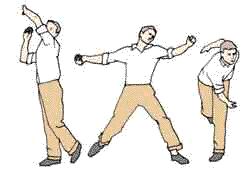 Again age 12, but this time Games (separate from PE!) and Overarm Bowling.
Again age 12, but this time Games (separate from PE!) and Overarm Bowling.Now, you might think, hold on - I thought you said we were discussing things used on a regular basis? But bear with me.
So, part of my current profession is to teach children useful things. The joy of working in the voluntary sector when approaching this, as opposed to my previous deviation in the teaching one, is that these things are actually Useful Things (as opposed to observing osmosis in rods of potato, or how to read the top quartile of a bell curve.)
This year, it has included everything from Where Plants Come From, through How To Make Paper Airplanes, to How To Climb A Wire Fence To Get To The Football Pitch. (Don't ask, don't tell.) And so, since Easter I've been turning up weekly at a local primary school (which, I must say, is arguably one of the best in all the land) to play Kwik Cricket with the P5-P7s. And in last week's session, I began passing on, almost verbatim, the principles of overarm bowling, which have stuck with me since third year of secondary school.
Now, it may surprise most people to find out that I'm not much of a sportsman. However, the joy of turning up to a school with the Children's Worker hat on is that it is automatically assumed you are an expert on everything. But let me tell you - whilst this might facilitate easier ways to get out of arguments ("Why?" "Because.") it does come with the caveat that you need to make sure you actually are right - for it shall come back to bite you on the backside. So, as the self-appointed cricketing guru, I've been relying mostly on the fact that I can, at least, bowl a decent fast-medium ball over a good length. And there's a couple of tricks, learnt all those years ago, that have helped ensure this - both at the start of the movement.
Firstly, get that second arm up. As you wind up and release, that arm needs to go straight down the line where you want to bowl, and you need to be looking behind and through it before you release. This makes a massive difference when you uncoil, as it makes sure that your shoulders are in line as your bowling arm comes over the top of your head.
Secondly, "bite the apple", as the original teacher in question insisted again and again. Don't hold the ball somewhere around your chest before your unwind - get it right up beside your mouth so you can smell it. That initial push forward your bowling hand makes whenever you release will therefore add power as the ball makes its journey down past your waist.
And thirdly, release at two - o'clock that is. A lot of the kids I've worked with so far let it go whenever their arm is perpendicular - possibly as an unfortunate product of one of the drills I've been using for fielding, which resembled something for tennis ball boys. Alternatively, you don't want to be releasing too late either, or it'll go straight in to the ground - a problem I'm having currently as I try to learn how to bowl right handed (being a natural southpaw). Two o'clock, at full stretch when you release, and that ball is going right down the batsman's throat. Howzat?


